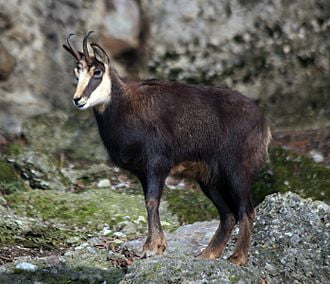Chamois

The chamois (Rupicapra rupicapra) is a species of goat-antelope native to mountains in Europe, from west to east, including the Cantabrian mountains, the Pyrenees, the Alps and the Apennines, the Dinarides, the Tatra and the Carpathian Mountains, the Balkan Mountains, the Rila – Rhodope massif, Pindus, the northeastern mountains of Turkey, and the Caucasus.[2]
The chamois has also been introduced to the South Island of New Zealand. Some subspecies of chamois are strictly protected in the EU under the European Habitats Directive.
The English name comes from French chamois. The latter is derived from Gaulish camox (attested in Latin, 5th century), itself perhaps borrowing from some Alpine language (Raetic, Ligurian). The Gaulish form also underlies German Gemse, Gams, Gämse, Italian camoscio, Ladin ciamorz.
The usual pronunciation for the animal is UK: /ˈʃæmwɑː/ or US: /ʃæmˈwɑː/, approximating the French pronunciation [ʃaˈmwa]. However, when referring to chamois leather, and in New Zealand often for the animal itself, it is /ˈʃæmi/, and sometimes spelt “shammy” or “chamy”.
The plural of “chamois” is spelled the same as the singular, and it may be pronounced with the final “s” sounded. However, as with many other quarry species, the plural for the animal is often pronounced the same as the singular.
The Dutch name for the chamois is gems, and the male is called a gemsbok. In Afrikaans, the name “gemsbok” came to refer to a species of Subsaharan antelope of the genus Oryx, and this meaning of “gemsbok” has been adopted into English.
The chamois is a very small bovid. A fully grown chamois reaches a height of 70–80 cm (28–31 in) and measures 107–137 cm (42–54 in) (the tail is not generally visible except when mating).[6] Males, which weigh 30–60 kg (66–132 lb), are slightly larger than females, which weigh 25–45 kg (55–99 lb).[6] Both males and females have short, straightish horns which are hooked backwards near the tip, the horn of the male being thicker.
In summer, the fur has a rich brown colour which turns to a light grey in winter. Distinct characteristics are white contrasting marks on the sides of the head with pronounced black stripes below the eyes, a white rump and a black stripe along the back.
